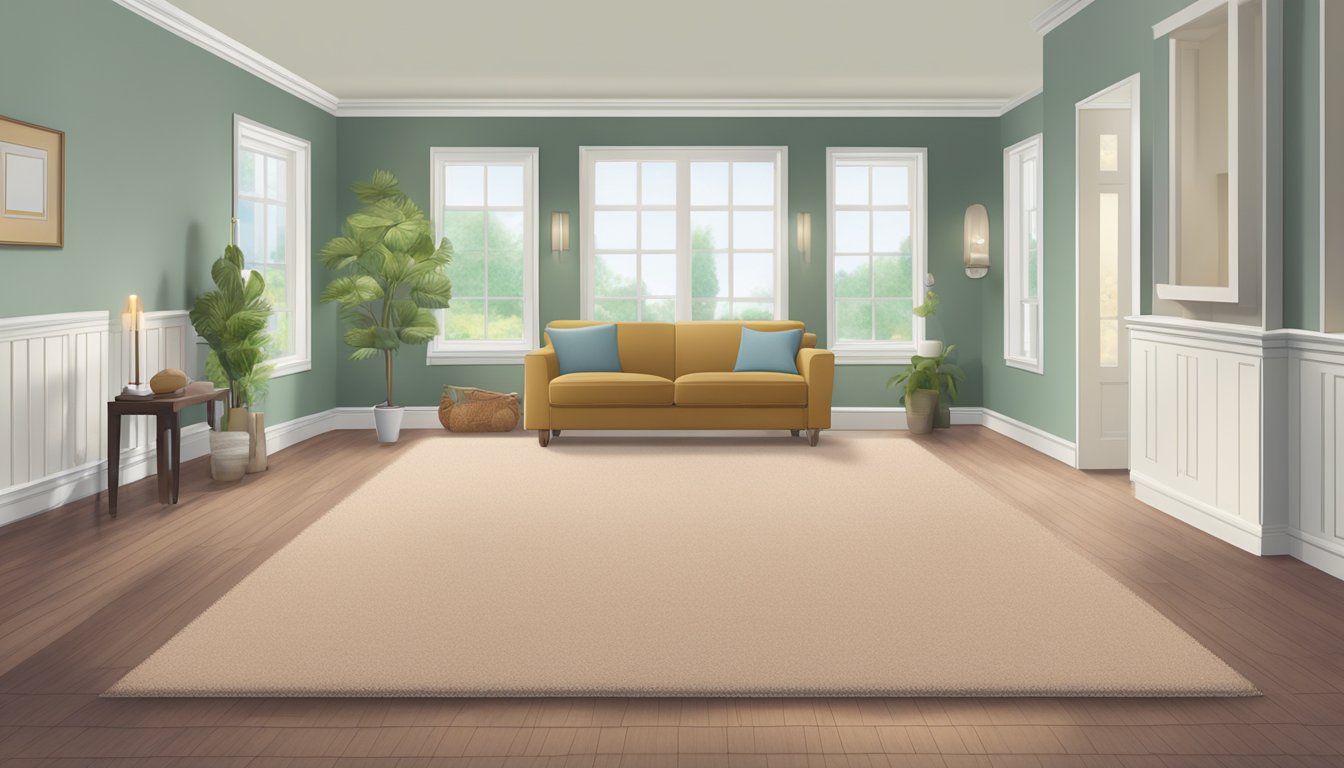When it comes to selling a home, homeowners often wonder whether they should replace their carpet before putting their house on the market. While some may see it as an unnecessary expense, others believe it can make a significant difference in the sale of their home. So, should you replace your carpet before selling your home?

One factor to consider is the condition of your current carpet. If your carpet is worn, stained, or outdated, it may be worth replacing. Potential buyers may be turned off by the appearance of the carpet, and it could negatively impact their perception of the overall condition of the home. On the other hand, if your carpet is in good condition and has been well-maintained, it may not be necessary to replace it.
Another factor to consider is the current market trends in your area. If most of the homes for sale in your area have updated flooring, it may be worth investing in new carpet to make your home more competitive. However, if carpet is still a popular choice in your area, it may not be necessary to replace it. Ultimately, the decision to replace your carpet before selling your home will depend on your specific situation and the preferences of potential buyers in your area.
Benefits of Replacing Carpet Before Selling

When it comes to selling a home, many homeowners wonder whether they should replace the carpet. While it may seem like an unnecessary expense, replacing the carpet can actually offer several benefits that can make a big difference in the sale of the property.
Enhancing Home Value and Marketability
One of the most significant benefits of replacing the carpet before selling a home is that it can enhance the property’s value and marketability. New carpet can give a home a fresh and updated look, making it more appealing to potential buyers. Additionally, if the carpet is old or worn, it can make the home look outdated and unappealing, which can turn off buyers.
Creating a Move-In Ready Impression
Another benefit of replacing the carpet is that it can create a move-in ready impression. Homebuyers often want to move into a home that is ready for them to live in without having to make significant renovations or updates. By replacing the carpet, homeowners can make their property more attractive to buyers who are looking for a move-in ready home.
Eliminating Pet Odors and Stains
Replacing the carpet can also help eliminate pet odors and stains, which can be a significant turnoff for potential buyers. Even if the carpet has been professionally cleaned, pet odors and stains can linger, making the home smell unpleasant. By replacing the carpet, homeowners can ensure that their property smells fresh and clean, which can help attract more buyers.
In summary, replacing the carpet before selling a home can offer several benefits, including enhancing the property’s value and marketability, creating a move-in ready impression, and eliminating pet odors and stains. While it may require an initial investment, replacing the carpet can ultimately pay off in a faster and more profitable sale.
Assessing the Condition of Your Current Carpet

Before making the decision to replace carpet before selling your home, it’s important to assess the condition of your current carpet. This will help you determine if it’s necessary to replace it or if it can be cleaned or simply left as is.
Identifying High-Traffic Areas and Wear
One of the first things to consider when assessing your carpet is the amount of wear and tear it has endured. High-traffic areas, such as hallways and entryways, tend to show more wear than other areas of the home. This can include flattened fibers, discoloration, and even visible stains. If your carpet is worn in these areas, it may be a good idea to replace it before selling your home.
Considering Carpet Age and Material Durability
The age of your carpet can also play a role in its condition. If your carpet is over 10 years old, it may be showing signs of wear and tear that can’t be cleaned or restored. In addition, the type of material your carpet is made of can affect its durability. Nylon is a popular choice for its durability, while polyester and wool may not hold up as well over time.
When assessing your carpet, it’s important to consider both the age and material to determine if replacement is necessary. While a stained carpet can be cleaned, worn or damaged carpet may need to be replaced to ensure your home looks its best when it comes time to sell.
Cost Analysis of Carpet Replacement

Carpet replacement is a common home improvement project that many homeowners consider before selling their home. However, the cost of carpet replacement can vary significantly depending on various factors. In this section, we will analyze the cost of carpet replacement and help homeowners understand the return on investment (ROI) for carpet upgrades.
Calculating Replacement and Installation Costs
The cost of new carpet is the primary expense that homeowners need to consider when replacing their carpet. The cost of new carpet can vary depending on the quality, material, and style of the carpet. On average, homeowners can expect to spend around $3-$6 per square foot for new carpet.
In addition to the cost of new carpet, labor costs for professional installation should also be taken into account. Professional installation costs can vary depending on the size of the room, the complexity of the installation, and the location. On average, professional installation costs can range from $2-$5 per square foot.
Alternatively, some homeowners may choose to install the carpet themselves to save on labor costs. While DIY installation can save money, it can also be time-consuming and may require specialized tools.
Understanding ROI for Carpet Upgrades
When considering carpet replacement, homeowners should also consider the ROI for the upgrade. The ROI for carpet upgrades can vary depending on the market and the quality of the carpet. In general, high-quality carpet can have a higher ROI than low-quality carpet.
According to a recent study, homeowners can expect to recoup around 50-75% of the cost of carpet replacement when selling their home. However, homeowners should also consider the time and effort required for carpet replacement and whether it is worth the investment.
In conclusion, carpet replacement can be a significant expense for homeowners, and the ROI for the upgrade can vary depending on various factors. Homeowners should carefully consider the cost of new carpet and professional installation, as well as the potential ROI for the upgrade, before deciding to replace their carpet.
Choosing the Right Carpet for Resale
When it comes to selling a home, the appearance of the flooring can play a significant role in the sale. Choosing the right carpet for resale can make a big difference in the overall appeal of the home. Here are some important factors to consider when selecting carpet for resale.
Selecting Materials and Textures
The type of material used for the carpet can impact the overall look and feel of the home. Natural fibers such as wool or silk can provide a luxurious feel, but can also be more expensive. Synthetic fibers such as nylon or polyester can be more affordable and offer a wider range of color options.
Texture is also an important factor to consider. Plush carpets can provide a cozy and inviting feel, while looped carpets can provide a more modern and sleek appearance. Berber carpets are a popular choice for their durability and versatility.
Color Choices and Stain Resistance
The color of the carpet can greatly affect the overall appearance of the home. Neutral colors such as beige or gray can appeal to a wider range of buyers, while bolder colors can be more polarizing. It is also important to consider the stain resistance of the carpet. Stain-resistant carpets can be a selling point for families with children or pets.
When selecting a carpet for resale, it is important to consider both the material and texture as well as the color and stain resistance. By choosing the right carpet, sellers can increase the appeal of their home and potentially increase the sale price.
Alternatives to Carpet Replacement
When selling a home, replacing the carpet can be a costly and time-consuming process. However, there are alternatives to carpet replacement that can improve the appearance of the carpet and make it more appealing to potential buyers.
Professional Deep Cleaning Options
One alternative to replacing the carpet is to have it professionally deep cleaned. A deep clean can remove stains, dirt, and odors that have accumulated over time, making the carpet look and smell like new again. Professional carpet cleaning services use specialized equipment and cleaning solutions to remove even the toughest stains and dirt. This can be a cost-effective option for homeowners who want to improve the appearance of their carpet without the expense of replacing it.
Evaluating the Benefits of Repairing Over Replacing
Another alternative to carpet replacement is to evaluate the benefits of repairing the carpet instead. If the carpet has minor damage, such as small tears or burns, it may be possible to repair it rather than replace it. This can be a cost-effective option that can make the carpet look almost new again. However, if the carpet is severely damaged or worn, replacing it may be the best option.
In conclusion, when selling a home, replacing the carpet may not always be necessary. Professional deep cleaning and repairing the carpet can be cost-effective alternatives that can improve the appearance of the carpet and make it more appealing to potential buyers. Homeowners should evaluate the benefits of repairing the carpet over replacing it to determine which option is best for their situation.

Shardai Augustus is a dedicated and compassionate real estate professional specializing in the Houston and Katy Texas areas. With a solid background in secondary education as a math teacher spanning over 10 years, Shardai combines her love for teaching with a caring approach when assisting her real estate clients.
